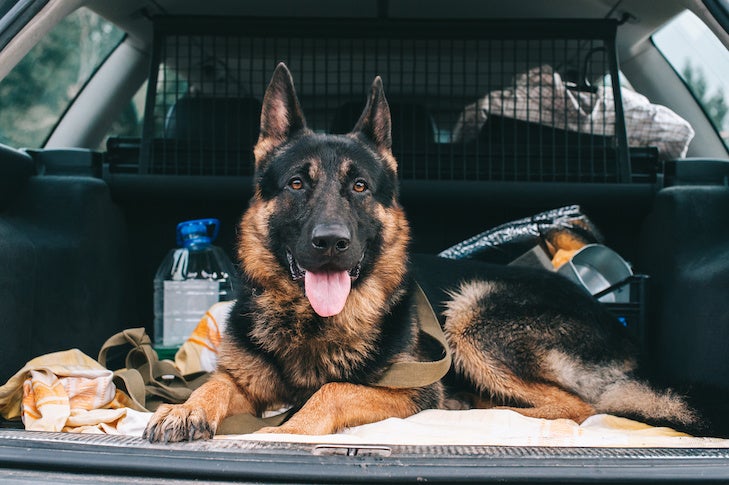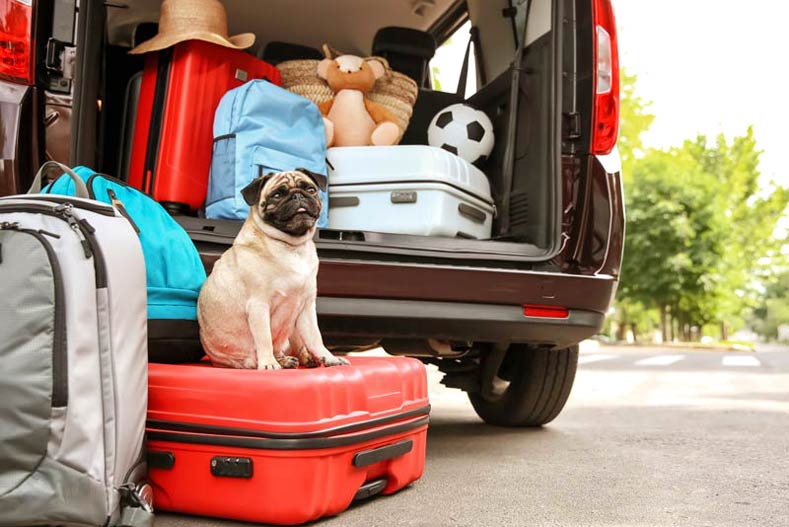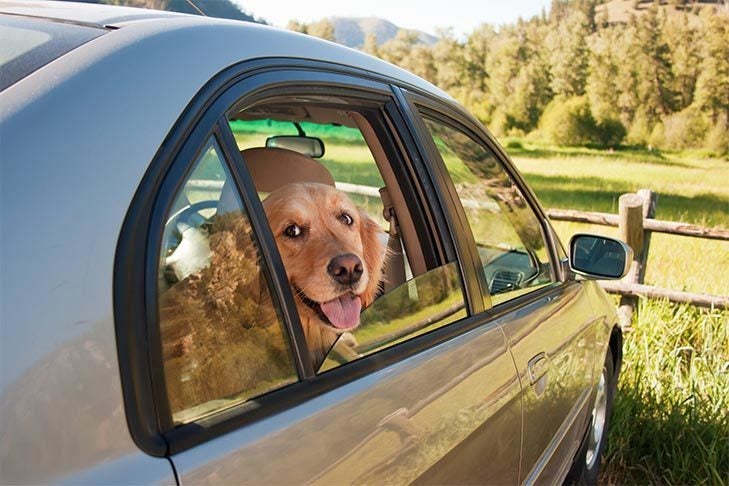
AKC is a participant in affiliate advertising programs designed to provide a means for sites to earn advertising fees by advertising and linking to akc.org. If you purchase a product through this article, we may receive a portion of the sale.
It’s a common problem. Your dog is the picture of perfect behavior at home, but in a new environment like a friend’s house or a hotel with an unforgiving accident fee, things may be a different story.
So what can those who like traveling with dogs do to help their pups adjust to new situations? To get answers, we spoke with Chris Gannon, also known as Chris the Dog Trainer. Gannon is an AKC Canine Good Citizen (CGC) evaluator and a master dog trainer with 30 years of experience. She also certifies therapy dog teams through Love on a Leash. For many years, she has traveled long distances between New York and Florida with her own dogs.
According to Gannon, most dog behavior issues that arise while traveling can be easily avoided by setting good routines in advance and being aware of certain training and traveling do’s and don’ts.

DO: Introduce New Environments Gradually
Gannon says the key to socialization is making sure your dog experiences new things, such as other animals, unfamiliar sights, and strange sounds in a controlled fashion.
“When I get a puppy, I generally introduce them to a cat, and let them know what a cat is like, what they look like, smell like, and that they’re not necessarily friendly,” says Gannon. “That way, from a very young age, dogs will know all about cats and how to interact with them for the rest of their lives.”
The same can be done for any new situation your puppy or young dog may encounter over their lives. Gannon recommends slowly introducing dogs to new situations like being in the car, going on a train, or staying over at a friend’s house or hotel. Start by practicing in short sessions and then gradually increasing the time from there.
Tips
- Have control.
- Be consistent.
- Introduce your dog to as many new things as possible, as safely as possible.
- Start young. Even with puppies, you can carry them or have them ride in the car to get exposed to bigger cities, loud trucks, and other new sights and sounds.
- Practice in a nearby pet-friendly hotel lobby before booking accommodations. Have your dog walk in, sit, and walk out, and make sure to praise their good behavior.
DO: Start Small
If you have time before your next vacation, practice ahead of your trip by taking your dog and a crate to a friend’s home. From there, Gannon says, you can leave your pet in another room, listen in, and even set up a tablet to video-conference in and see how things are going. If they’re sitting there quietly, you can say through the video software, “Quiet, good quiet,” so that, even though they can’t see you physically in the room, they know you’re there watching.
“Now when you go on a trip, your dog has already practiced,” explains Gannon. “I do it as often as I can. Mix it up when possible as well.”
- If you’re doing crate training, keep doing the same things you’re doing at home while on the go.
- Bring familiar items like your dog’s towel or blanket.

DO: Teach What Good Car Behavior Looks Like
- Open the two back doors of the car.
- Put two leashes on your dog.
- With two adults present, walk your dog to the car, with one adult standing next to one of the open back doors, and another on the opposite side.
- Have one person practice getting your dog in and out from one side of the car.
- Finally, practice having your dog get in and out of the car from the other side.
The goal of this exercise is to have the dog accomplish the task while maintaining a calm, even demeanor. Once your pup graduates from this activity, you can have a friend practice driving you and your dog around, with the two of you seated in the back seat.
DO: Encourage Positive Traveling Behavior
To us, the things our dogs are doing may not seem like a big deal, but something as small as sitting in a new house or hotel lobby may feel like a big accomplishment.
“The best thing you can do when traveling is letting your dog know, ‘you’ve got this,'” says Gannon. “The more praise we can give them, the more confident they become.”
DO: Keep Up Good Routines and a Calm Tone
“When traveling with dogs, we think we want to give them a great vacation,” says Gannon. But we often think about trips through the lens of the human experience.
Some people may think that, because they don’t like rules on vacation, their dog doesn’t need them either. That’s a mistake, Gannon says, as routines help dogs thrive.
Tips
- Practice leadership and being calm.
- Reinforce rules.
- Help your dog be calm, relaxed, and happy.
DO: Be Aware of Stressful Elements of Traveling
Even dogs that act calm and obedient at home may be startled or act differently in situations that frighten or stress them out. Gannon says things like crowds and loud noises may be problematic.
DO: Redirect Issues as They Arise
Instead of correcting, Gannon says it’s best to walk away or redirect when your dog begins having challenges. If needed, put your dog in a crate or keep them on a leash to maintain control over the situation.
DO: Keep Your Dog Occupied With Toys
Your dog may just need to blow off a little steam or focus on something different other than all the new stimuli involved with traveling. Having a few toys around can help give your pup something else to look at and focus on.
DON’T: Set Expectations You Can’t Maintain
For instance, while you’re traveling in the car, it may seem like a good idea to sit next to your dog and pet them. But doing so early on may establish a routine wherein dogs think they’ll get petted every time. This may lead to issues when you’re unable to fulfill that expectation every time.

DON’T: Encourage Troubling Behaviors
“Every moment you spend with your dog, you’re teaching them something,” says Gannon. Some of that includes the things you may not want to be teaching.
If you allow or encourage things like panting at the window or circling in the backseat of the car, you’re letting your dog think those things are acceptable.
Tips
- Never take your dog out of the car when they’re jumping around.
- Don’t introduce your dog to new situations in an excitable way, as this may make them overly animated.
- Establish expectations for travel in the car. This is a time for relaxing and taking a nap, not being excited.
DON’T: Inadvertently Praise a Fearful or Anxious Dog
One of the biggest mistakes owners can make is to vocally give dogs sympathy and empathy in a way that comes across as praising a negative behavior. Gannon explains that saying things like “It’s okay, it’s okay,” can actually be harmful.
While you may think you’re calming your dog down with your voice, it actually may translate to them as praise for fearful behavior. Instead, try saying “leave it” when a dog is anxious or giving them a command they can be praised for, such as “sit.”
Traveling with your dog can be one of the best things about a vacation. As with any aspect of travel, good preparation is key, however, so make sure you establish good behavior from your dog from the start to maximize enjoyment.
Need some help training your dog? While you may not be able to attend in-person training classes during COVID-19, we are here to help you virtually through AKC GoodDog! Helpline. This live telephone service connects you with a professional trainer who will offer unlimited, individualized advice on everything from behavioral issues to CGC prep to getting started in dog sports.


